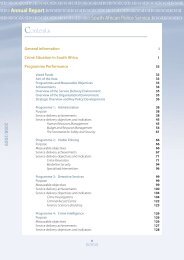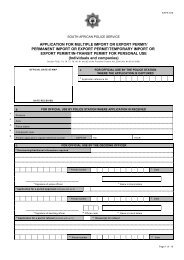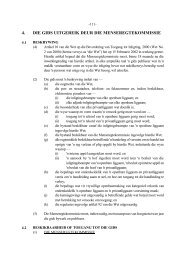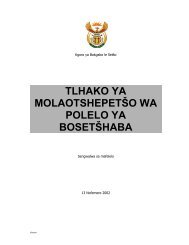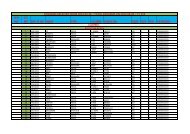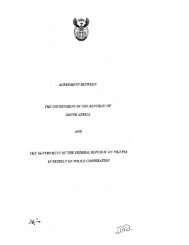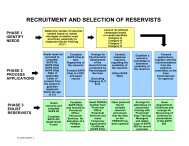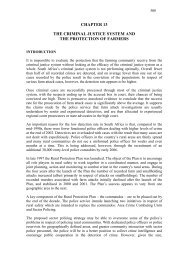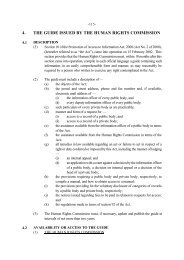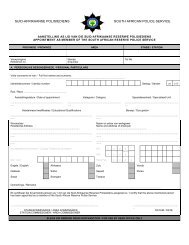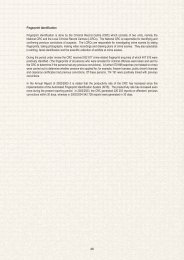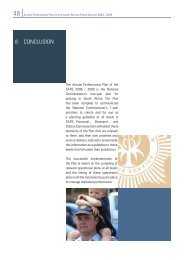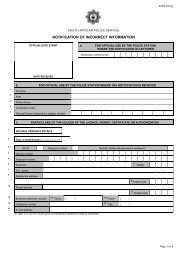Untitled - Saps
Untitled - Saps
Untitled - Saps
Create successful ePaper yourself
Turn your PDF publications into a flip-book with our unique Google optimized e-Paper software.
• A revised Rural Safety Programme was developed. The crime-prevention strategy in this<br />
instance involved a number of rural stakeholders such as women’s groups, traditional<br />
leaders, agricultural unions and farm labourers, as well as law-enforcement agencies.<br />
• The National Instruction for the South African Reserve Police Service was approved<br />
and circulated in the SAPS. The instruction dealt with all issues regarding Rests and<br />
was aimed at assisting the service in attaining its aim of strengthening community<br />
involvement and recruiting 30 000 Rests.<br />
• In 2001/2002, the Division Training brought its education, training and development<br />
skills priorities in line with the National Strategic Priorities of the SAPS.<br />
• The SAPS focused on the optimization of crime statistics, operational training, functional<br />
training, detective training, crime intelligence training, and management and leadership<br />
development. A total of 4 711 courses were presented and 58 000 members underwent<br />
training.<br />
• In 2001/2002, 2 378 members were trained in the Crime Administration System and<br />
810 members underwent training in respect of crime definitions and crime information<br />
analysis.<br />
• The main training focus for 2002/2003 was basic training. The SAPS trained 7 100 new<br />
students from June 2002 at its training facilities in Pretoria, Oudtshoorn, Graaff-Reinet,<br />
Bisho and Chatsworth, as well as at Maleoskop, Slagboom and Jakkalsdans.<br />
• In May 2002, the first Firearm Registration Centre in the country was officially opened.<br />
Firearm Registration Centres were established as part of the implementation of the<br />
Designated Police Officer Model as prescribed by the Firearms Control Act, 2000 (Act<br />
No 60 of 2000).<br />
• Operation Tsipa was conceptualized as a special, targeted operation within Operation<br />
Crackdown for those wards where stabilization had not been achieved yet. Operation<br />
Tsipa ran from 28 January 2002 to 15 March 2002. The operation was carried out<br />
by teams comprising members from various SAPS units, assisted by members of the<br />
SANDF, the Department of Home Affairs, local traffic departments, SARS, other<br />
relevant government departments and local municipalities.<br />
• The SAPS invested substantially in new technology such as the Movement Control<br />
System which was installed at border posts and airports in September 2002. The SAPS<br />
Border Police operated at 53 land border posts, ten air border posts and nine sea border<br />
posts. As a result of the Movement Control System, as well as other new technology such<br />
as mobile luggage scanners, x-ray scanners, body scanners and a traffic-flow system, a<br />
noticeable increase in the number of seizures of illicit and illegal items was reported.<br />
• Another form of technology that was implemented and which proved to be extremely<br />
valuable to the SAPS was the Automated Fingerprint Identification System (AFIS).<br />
Women’s Day 2002: Female and male members of all ranks<br />
handed out flowers to motorists. Divisional Commissioner<br />
Lindiwe Mtimkulu was among them. (Picture: courtesy Pretoria News)<br />
• In terms of drug-related successes over the period 1 January 2002 to 31 December 2002,<br />
mandrax tablets with an estimated value of R80 million, eConstasy with a value of R1<br />
billion, cocaine to the value of R334 million and heroin to the value of R2 million<br />
were seized during the Organized Crime Unit’s operations. In respect of vehicle-related<br />
successes over the same period, Organized Crime units recovered vehicles with an<br />
estimated value of R92 million and vehicle components to the value of R6 million.<br />
• Preventing and combating crimes against women and children remained a priority<br />
in the 2002/2003 financial year. The Family Violence, Child Protection and Sexual<br />
Offences units arrested 15 861 offenders during this period, resulting in 98 terms of life<br />
imprisonment being handed down by the courts and 14 918 years’ imprisonment being<br />
meted out.<br />
• As terrorism was becoming a matter of international concern, the Crime Intelligence<br />
Division and the Detective Service proved to be effective. Intelligence indicated that a<br />
group of extremists, known as the Boeremag, was planning a military-type coup and had<br />
devised a detailed plan to overthrow the South African government. An integrated task<br />
team comprising intelligence operatives, detectives and other police specialists arrested a<br />
number of prominent members of this group, effectively neutralizing the threat.<br />
41



